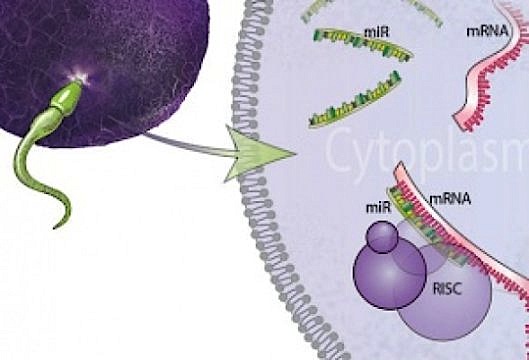|

CLICK ON weeks 0 - 40 and follow along every 2 weeks of fetal development
|
||||||||||||||||||||||||||||
Sperm RNAs in the egg may predict successful birth Human sperm may hold the potential to serve as biomarkers for the future health of newborn infants, according to a new study by a Wayne State University School of Medicine research team. Published in the peer-reviewed journal Systems Biology in Reproductive Medicine, the study from the lab of Stephen Krawetz indicates that RNA found in male sperm not only shows promise as a determinant of successful live birth, but may also predict a child's health through life. "We explored the opportunity of using sperm RNA elements as a predictor of human health, with intended application to fertility clinics. Such information would go hand-in-hand with new neonatal intensive care genome sequencing to improve infant health outcomes. The intriguing possibility is that, while sperm RNAs delivered to the egg inform the success of live birth, they may also open a pathway to understanding the birth and potential health of each child as well." At fertilization, a single sperm delivers to an egg its entire genome packaged within its nucleus, along with a complement of ribonucleic acids (RNAs) and proteins. To test their hypothesis that sperm RNAs may be useful in predicting live birth outcomes, sperm RNAs that correspond to specific disease genes were also identified. Dr. Krawetz's team surveyed a total of 278,605 sperm RNA elements called short exon-sized sequences, or SREs, known to be associated with diseases. This group of SREs might help indicate a particular gene or set of genes linked to a disease. Such information would not only provide an improved understanding of the father's contribution to the life of the child, but also to the current state of a father's own health. In the future, if SREs that are mutated or modified can all be identified, researchers and physicians may be able to not only forecast disease or identifiable conditions thay may affect an infant, but develop ways to prevent them or modify the impact of their affect on the baby. Abstract Idiopathic infertility, an etiology not identified as part of standard clinical assessment, represents approximately 20% of all infertility cases. Current male infertility diagnosis focuses on the concentration, motility, and morphology of spermatozoa. This is of limited value when predicting birth success and of limited utility when selecting the optimum treatment. At fertilization, spermatozoa provide their genomic contribution, as well as a set of RNAs and proteins that have distinct roles in development. The potential of spermatozoal RNAs to be used as a prognostic of live birth has been shown [Jodar et al. (2015) Science Translational Medicine 7(295):295re6]. This relied on a set of 648 sperm RNA elements derived from 285 genes that are perhaps indicative of future health status. To address this tenet, the present study correlated the levels of each transcript among all samples to assess linkage between transcript absence, birth success, and possible disease association. Correlations between transcript levels of the 285 genes were analyzed amongst themselves, and within the context of the entire transcript population for these samples. The transcripts ACE, GIGYF2, and ODF2 had many negative correlations and form the majority of correlations, suggesting an important function for these transcripts. Eleven of the 285 queried genes had disease-associated variants within a sperm RNA element. Three genes, GPX4, NDRG1, and RPS24 had SREs were absent in at least one individual from the test cohort. GPX4 and RPS24 are associated with developmental defects and/or neonatal lethality. This leaves the intriguing possibility that, while sperm RNAs delivered to the oocyte inform the success of live birth, they may also be predictors of human health. Authors: Rayanne B. Burl, Stephanie Clough, Edward Sendler, Molly Estill & Stephen A. Krawetz Return to top of page |
Dec 14, 2017 Fetal Timeline Maternal Timeline News News Archive  On the left of this image, a human sperm is beginning to penetrate the egg cell wall. On the right, the interior of the egg cell reflects some of the sperm genetic donation to the new individual to be created. Image credit: University of Pennsylvania.
|
||||||||||||||||||||||||||||

